group和class
Group Cooperative Learning in English Class
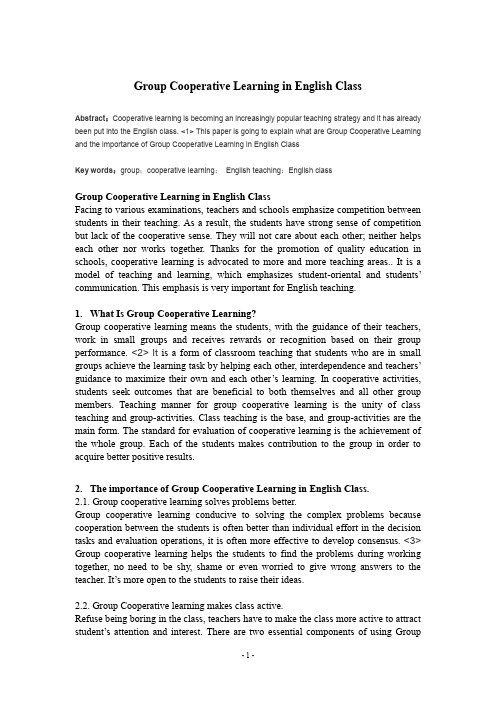
Group Cooperative Learning in English ClassAbstract:Cooperative learning is becoming an increasingly popular teaching strategy and it has already been put into the English class. <1> This paper is going to explain what are Group Cooperative Learning and the importance of Group Cooperative Learning in English ClassKey words:group;cooperative learning;English teaching;English classGroup Cooperative Learning in English ClassFacing to various examinations, teachers and schools emphasize competition between students in their teaching. As a result, the students have strong sense of competition but lack of the cooperative sense. They will not care about each other; neither helps each other nor works together. Thanks for the promotion of quality education in schools, cooperative learning is advocated to more and more teaching areas.. It is a model of teaching and learning, which emphasizes student-oriental and students’communication. This emphasis is very important for English teaching.1.What Is Group Cooperative Learning?Group cooperative learning means the students, with the guidance of their teachers, work in small groups and receives rewards or recognition based on their group performance. <2> It is a form of classroom teaching that students who are in small groups achieve the learning task by helping each other, interdependence and teachers’guidance to maximize their own and each other’s learning. In cooperative activities, students seek outcomes that are beneficial to both themselves and all other group members. Teaching manner for group cooperative learning is the unity of class teaching and group-activities. Class teaching is the base, and group-activities are the main form. The standard for evaluation of cooperative learning is the achievement of the whole group. Each of the students makes contribution to the group in order to acquire better positive results.2.The importance of Group Cooperative Learning in English Class.2.1. Group cooperative learning solves problems better.Group cooperative learning conducive to solving the complex problems because cooperation between the students is often better than individual effort in the decision tasks and evaluation operations, it is often more effective to develop consensus. <3> Group cooperative learning helps the students to find the problems during working together, no need to be shy, shame or even worried to give wrong answers to the teacher. It’s more open to the students to raise their ideas.2.2. Group Cooperative learning makes class active.Refuse being boring in the class, teachers have to make the class more active to attract student’s attention and interest. There are two essential components of using Groupcooperative learning that help to assure the class active.2.2.1. Positive interdependence to each other in a group. Positive interdependence means that each group member should recognize that if an activity is beneficial to one member; it will be helpful to the whole group. It helps the students to apply this spirit in their further social life also, to help the students to understand the “win-win” rules in the sociality. For example, if one student find the answer, he/she would share with others in group, may collect different ideas of the answers, which would give more explanation or quicker, easier way to the answer.2.2.2. Individual and group accountability. The group accountability is achievements of the group goals, and the individual accountability is contributions of the member’s share of the work. Each of the group members has responsibility to finish his/her own task and help other group members who need more assistance, support and encouragement in studying. Teachers examine students’accomplishment of their individual accountability by a) giving marks to each group members and b) asking any of them to report his/her group’s result irregularly.2.3. Group Cooperative learning emphasizes student-centre.Group cooperative learning gets rid of the traditional teaching model in which there is only the communication between teachers and students. Communication between students is the emphasis of cooperative learning. It is important for English teaching. Doing cooperative learning in English class can not only impel students’learning activities, but also improve the environment of the class and develop students’personality.2.4. Group Cooperative learning benefits students in improving their oral English and communicational ability.In traditional English class, teachers speak most of the time; students just listen and accept the knowledge. Only a few students have chances to speak the target language. Moreover, the students that have the chance in the class only speak according to the model that the teachers set for them. They speak but not communicate. By contrast, a cooperative learning class provided students with much more opportunities to join in communication through the group activities. And the topics they talk about are closed to their daily life. There is no doubt that the students’ability of using English, especially of using oral English is better.2.5. Group Cooperative learning benefits students for developing their personality. Knowledge can be absorbed and expressed only if the learners do think and practice independently. Whether students accept the knowledge with pessimism or learnt with activism will influence the teaching effect. In traditional English teaching, students depend on teachers too much. They listen to the teacher without thinking; the teacher’s answer is always right and unique. Their personalities are confined in this kind of learning. However, teachers just teach the new language points to students briefly in cooperative learning class. In most of the time in the class, students studywith their group members. Teachers encourage students to help each other to accomplish the task. They no longer criticize and rebuke the students but guide them and give them enlightenment. Students would be free to laugh at themselves by making mistakes. By this way, student’ specific aptitude will be showed completely.3.How and when to use Group Cooperative Learning in English Class moreeffectiveIn traditional English teaching, teachers train one skill of students only in the reading / oral/ listening/ writing class. However, students’ integrated skills---reading, speaking, listening and writing can be trained with cooperative learning in one class. Students who do reading in cooperative learning class have chances to share their ideas to their group members and the whole class by speaking out, other students’ listening would be trained at the same time. Also ask the students to write down what they heard, students would benefit from the writing skill. Using group cooperative learning activity models is a real way to practice cooperative learning.Let’s see the difference of the follow two groups’ activities below.Practice in a speaking training class: comparing group A and group B.3.1. Teaching material: Unit 57, Intermediate EnglishTeaching objects: students in two normal classes3.1. 1.Teaching plan for traditional speaking class.Teaching aims:A. Knowledge aims:1)Students get to know some extreme sports.2)Students learn some useful expressions.3)Students can use the expressions to retell the name and description ofextreme sports.B. Process and method aims:1)Develop students’ speaking skill.2)Guide students to find out the useful expressions and use them in someexercises.3)Enable students to retell the characteristics of name and description of theextreme sports with the given words.4)Get all of the students to join in the class activity enthusiastically bydiscussion in smaller groups.C. Emotion, attitude and value aims: Students know the difference of the extreme sports better.Teaching contents:1.The oral English material.eful expressions and some exercises.3.Retelling: the characteristics of the strange extreme sports.Teaching focus:1.The oral English material.2.The useful expressions.Teaching difficulty:1. Students should understand the questions given by the teacher and from the material.2. How to guide the students to retell with the given words.3.1. 2. Teaching plan for group cooperative speaking class.Teaching aims:A. Knowledge aims:1)Students get to know some strange extreme sports and some usefulexpressions in the book.2)Students learn some useful expressions.3)Students would share the kinds of extreme sports with the picture theycollect before class.B. Process and method aims:Students work in pairs and finish different tasks.Task 1: Understand the text and ask some questions according to the text in order to do a good job in the group competition later.Task 2: Find out and learn the useful expressions together.Task 3: Walk out the classroom and do some interviews with others in English, ask teachers or students what kinds of extreme sports they’ve tried or they would like to try and why.Task 4: Present other kinds of extreme sports with the picture that they collect before class.Task 5: Make a quick presentation according to the interviews, and present in the group.C. Emotion, attitude and value aims:1)Students know the kinds of the extreme sports better.2)Develop students’ ability to study independently.3)Develop students’ ability to cooperate with their group mates.Teaching contents:1.The characters of the new extreme sports.eful expressions and some exercises.3.Present other kinds of extreme sports.4.Students’ cooperation in pair/group work.Teaching focus:1.The speaking material.2.The useful expressions.3.The students’ performance.4.The students’ collaboration.Teaching difficulty:1.How to guide the cooperative work in the groups.2.How to persuade the students to speak out and communicate with others withconfidence and freely.3.How to guide the interviewers to share more information.4.How to present with the information students collect from the interview.3.2. ConclusionAccording to the two groups, the difference between the traditional class and the group cooperative learning class can be found easily:a) Differences in teaching aims. The aims of the traditional class are about speaking skills and language skills, while in cooperative learning class, the aims include training students’cooperative skills besides those aspects. That is to say, in the cooperative learning class, students’task is not only to learn the knowledge of language but also to communicate with other students and the teachers.b) Differences in teaching difficulties. In cooperative learning class, the teacher has to teach students cooperative skills. How to guarantee that students wish to work together is more significant to the teachers.c) Differences in teaching process. In traditional class, students communicate with the teacher most of the time. And there is only one manner---ask and answer. Comparing with the traditional class, the atmosphere in the cooperative learning class is more positive, comfortable and active. The pair/group cooperation in this class is not only for the speaking task but also for checking the result of the students’cooperation. Most of the time, students learn by themselves, pre-individual work, pair work and group work. Speaking out is a process of input, this kind of class is better for students to transform the language input into output.Compare with the differences between these two kinds of classes are caused by their different essential aims. Although group cooperative learning is good for students to improve their communication skills and cooperative ability, teachers must know all the students’ characteristics or they cannot form the groups well. And whether the group members wish to share and work together is the key of the class. Before the class, teachers have to introduce some cooperative skill s to the students, make them believe that they can work together well and finish the tasks. Students’ initiative to learn drives different results of the class.3.3. The shortcomings of group cooperative learningThe cooperative learning also has some obvious negative points.1)When the students’ English proficiency disparity is bigger in the group,good students harvest slightly.2)Poor students might be hurt and discouraged to learn and speak morebecause of their not skillful English or cooperation.3)Students might not be able to realize and point out the error during thegroup learning.4)Cannot guarantee the students to use English only during discussion andcooperation.5)Some of the students might be lack of communication and cooperationskills, it would drive the teaching plan out of control and effect furtherlearning and practices.Facing to the shortcomings mentioned above. Teachers have to learn more how to use group cooperative learning, pay more attention to the guidance of the group activities, giving equal chance to not only top students but also the medium and inferior ones for their expression of their own ideas and encouraging students to give help to each other in cooperative learning groups are needed.Group Cooperative learning becomes more common an popular in teaching and learning in China. It is different from competitive learning and individualistic learning, but contains these two at the same time. More and more teachers try to use cooperative learning because of its significant in language teaching. However, group cooperative learning cannot be used all the times. Teachers must make teaching plan with the thinking of the personality of their students, the contents they are going to teach, and the classroom they are going to use. Without these elements, group cooperative learning cannot shine. Whether group cooperative learning is used successfully or not, students’cooperative skills are the key point for it. Thereby, another important thing for teachers is teaching students how to wish to cooperate with others. Cooperative and communication skills are learning skills. It helps students learn self-oriental and interest-oriental.Teachers can develop the theories and active ways of group cooperative learning. With continue practice, they may develop a particular group cooperative learning method, which is suitable for Chinese students and teachers’ own characters.<1> The Reflection of Cooperative Learning in English Class, 刘果果魅力中国2011年第2期<2>,<3> Group Cooperative Learning in English Class, 仲卫利。
python group 用法

python group 用法在Python中,可以使用`group()`方法来匹配和提取正则表达式中的分组。
该方法返回由所有匹配的分组组成的元组。
以下是关于python `group()`方法的使用介绍和示例:1. 语法:```group([group1, ...])```其中,group1代表第一个要获取的分组的索引,以此类推。
如果没有提供任何参数,则默认返回整个匹配的子字符串。
2. 示例1 - 获取整个匹配的子字符串:```import repattern = r"ab"text = "abab"match = re.search(pattern, text)print(match.group()) # 输出: ab```3. 示例2 - 获取特定分组的子字符串:```import repattern = r"(a)(c)(e)"text = "abcdef"match = re.search(pattern, text)print(match.group(2)) # 输出: c```4. 示例3 - 获取所有分组的子字符串:```import repattern = r"(a)(c)(e)"text = "abcdef"match = re.search(pattern, text)print(match.group()) # 输出: aceprint(match.groups()) # 输出: ('a', 'c', 'e')```5. 示例4 - 使用多个分组:```import repattern = r"(\w+),(\w+)"text = "John,Doe"match = re.search(pattern, text)print(match.group(1)) # 输出: Johnprint(match.group(2)) # 输出: Doeprint(match.groups()) # 输出: ('John', 'Doe') ```6. 示例5 - 在匹配和提取时使用命名分组:```import repattern = r"(?P<first>\w+),(?P<last>\w+)"text = "John,Doe"match = re.search(pattern, text)print(match.group('first')) # 输出: Johnprint(match.group('last')) # 输出: Doe```7. 示例6 - 在多次匹配时使用分组:```import repattern = r"(\d+)-(\d+)"text = "1-2 3-4 5-6"matches = re.findall(pattern, text)for match in matches:print(match[0]) # 输出: 1, 3, 5print(match[1]) # 输出: 2, 4, 6```8. 示例7 - 使用分组来替换字符串中的部分内容: ```import repattern = r"(\d+)-(\d+)"text = "1-2 3-4 5-6"replaced_text = re.sub(pattern, r"\2-\1", text)print(replaced_text) # 输出: 2-1 4-3 6-5```总结:`group()`方法用于匹配和提取正则表达式中的分组,在合适的场景下可以方便地获取子字符串或进行替换操作。
人教新版 英语六年级上册 第一单元中文翻译
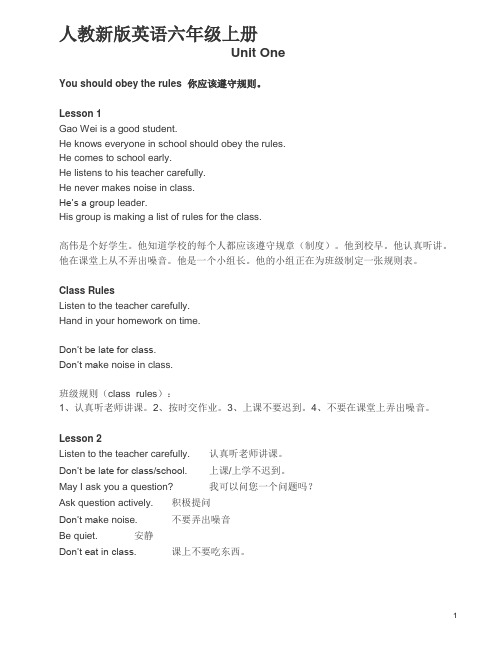
人教新版英语六年级上册Unit OneYou should obey the rules 你应该遵守规则。
Lesson 1Gao Wei is a good student.He knows everyone in school should obey the rules.He comes to school early.He listens to his teacher carefully.He never makes noise in class.He’s a gro up leader.His group is making a list of rules for the class.高伟是个好学生。
他知道学校的每个人都应该遵守规章(制度)。
他到校早。
他认真听讲。
他在课堂上从不弄出噪音。
他是一个小组长。
他的小组正在为班级制定一张规则表。
Class RulesListen to the teacher carefully.Hand in your homework on time.Don’t be late for class.Don’t ma ke noise in class.班级规则(class rules):1、认真听老师讲课。
2、按时交作业。
3、上课不要迟到。
4、不要在课堂上弄出噪音。
Lesson 2Listen to the teacher carefully. 认真听老师讲课。
Don’t be late for class/school.上课/上学不迟到。
May I ask you a question? 我可以问您一个问题吗?Ask question actively. 积极提问Don’t ma ke noise. 不要弄出噪音Be quiet. 安静Don’t eat in class. 课上不要吃东西。
Peter is a good student at school. But sometimes he is not a good boy at home. He often makes a mess in his room. He doesn’t like to help to set the dinner table. He watches TV the wh ole evening. He reads in bed and he goes to bed very late. Peter’s mother writes some home rules for him:Home RulesYou should:1. Help to set the dinner table2. Go to bed early.3. Keep your room clean.You shouldn’t:1. Read in bed.2. Watch TV till late.3. Make a mess in your room.彼得在学校里是一个好学生。
北美防爆标准

北美防爆标准摘要:1.北美防爆标准的概述2.北美防爆认证的分类3.Class、Division、Group 的含义及划分4.爆炸性气体和可燃性粉尘场所的防爆标志5.国际防爆标准与北美防爆标准的对比6.北美防爆认证的产品优势正文:一、北美防爆标准的概述北美防爆标准主要针对在爆炸性气体和可燃性粉尘环境下使用的设备和产品,其目的是确保这些设备和产品在使用过程中的安全性能。
北美防爆标准相较于国际防爆标准有一定的地区限制,但在可靠性和安全性方面具有较高的要求。
二、北美防爆认证的分类北美防爆认证主要分为两类:Class 和Division。
其中,Class 代表防爆等级,Division 代表防爆组别。
这两者的划分主要是根据设备在使用过程中可能产生的爆炸性气体、蒸气或可燃性粉尘的类型和浓度来确定的。
三、Class、Division、Group 的含义及划分1.Class:分为Class I 和Class II 两类。
Class I 主要针对气体爆炸环境,而Class II 主要针对粉尘爆炸环境。
2.Division:分为Division 1、Division 2 两类。
Division 1 代表存在或可能形成爆炸或燃烧的场所,而Division 2 代表不存在或不可能形成爆炸或燃烧的场所。
3.Group:分为Group A、B、C、D 四类。
Group A 代表气体爆炸环境,Group B 代表蒸气爆炸环境,Group C 代表粉尘爆炸环境,而Group D 代表不明确的爆炸环境。
四、爆炸性气体和可燃性粉尘场所的防爆标志在爆炸性气体和可燃性粉尘场所,设备和产品的防爆标志通常由以下几部分组成:1.Class 和Division 的代号:例如,Class I、Division 1 表示该设备或产品适用于气体爆炸环境,且存在或可能形成爆炸或燃烧的场所。
2.Group 的代号:例如,Group A、B、C 表示该设备或产品分别适用于气体、蒸气和粉尘爆炸环境。
group和groups用法
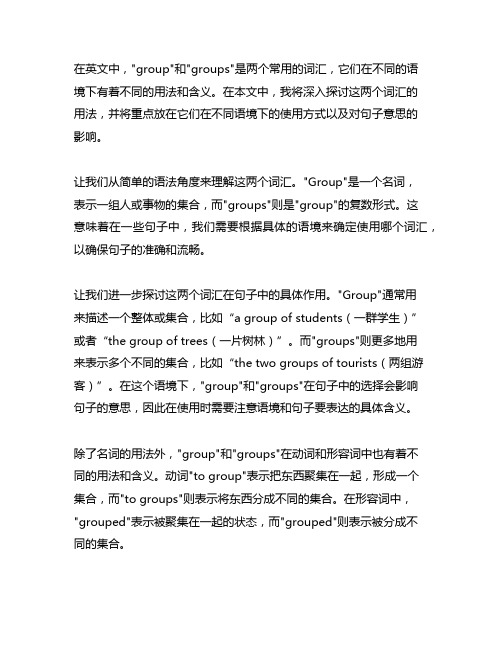
在英文中,"group"和"groups"是两个常用的词汇,它们在不同的语境下有着不同的用法和含义。
在本文中,我将深入探讨这两个词汇的用法,并将重点放在它们在不同语境下的使用方式以及对句子意思的影响。
让我们从简单的语法角度来理解这两个词汇。
"Group"是一个名词,表示一组人或事物的集合,而"groups"则是"group"的复数形式。
这意味着在一些句子中,我们需要根据具体的语境来确定使用哪个词汇,以确保句子的准确和流畅。
让我们进一步探讨这两个词汇在句子中的具体作用。
"Group"通常用来描述一个整体或集合,比如“a group of students(一群学生)”或者“the group of trees(一片树林)”。
而"groups"则更多地用来表示多个不同的集合,比如“the two groups of tourists(两组游客)”。
在这个语境下,"group"和"groups"在句子中的选择会影响句子的意思,因此在使用时需要注意语境和句子要表达的具体含义。
除了名词的用法外,"group"和"groups"在动词和形容词中也有着不同的用法和含义。
动词"to group"表示把东西聚集在一起,形成一个集合,而"to groups"则表示将东西分成不同的集合。
在形容词中,"grouped"表示被聚集在一起的状态,而"grouped"则表示被分成不同的集合。
"group"和"groups"在英文中有着不同的用法和含义,我们需要根据具体的语境和句子要表达的意思来选择使用哪一个。
两岸IT常术语对照表
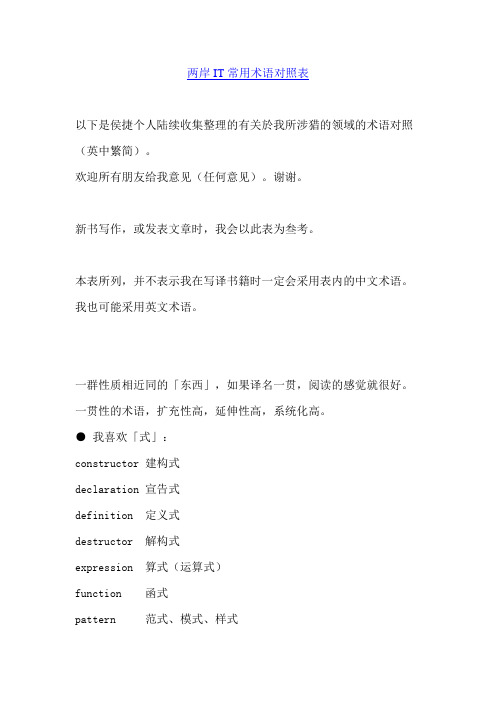
两岸IT常用术语对照表以下是侯捷个人陆续收集整理的有关於我所涉猎的领域的术语对照(英中繁简)。
欢迎所有朋友给我意见(任何意见)。
谢谢。
新书写作,或发表文章时,我会以此表为叁考。
本表所列,并不表示我在写译书籍时一定会采用表内的中文术语。
我也可能采用英文术语。
一群性质相近同的「东西」,如果译名一贯,阅读的感觉就很好。
一贯性的术语,扩充性高,延伸性高,系统化高。
● 我喜欢「式」:constructor 建构式declaration 宣告式definition 定义式destructor 解构式expression 算式(运算式)function 函式pattern 范式、模式、样式program 程式signature 标记式(签名式/署名式)● 我喜欢「件」:(这是个弹性非常大的可组合字)assembly (装)配件component 组件construct 构件control 控件event 事件hardware 硬件object 物件part 零件、部件singleton 单件software 软件work 工件、机件● 我喜欢「器」:adapter 配接器allocator 配置器compiler 编译器container 容器iterator 迭代器linker 连结器listener 监听器interpreter 直译器translator 转译器/翻译器● 我喜欢「别」:class 类别type 型别● 我喜欢「化」:generalized 泛化specialized 特化overloaded 多载化(重载)● 我喜欢「型」:polymorphism 多型genericity 泛型● 我喜欢「程」:process 行程/进程(大陆用语)thread 绪程/线程(大陆用语)programming 编程●英中繁简编程术语对照英文繁体译词(有些是侯捷个人喜好,普及与否难说)大陆惯用术语---------------------------------------------------------------------------------------#define 定义预定义abstract 抽象的抽象的abstraction 抽象体、抽象物、抽象性抽象体、抽象物、抽象性access 存取、取用存取、访问access level 存取级别访问级别access function 存取函式访问函数activate 活化激活active 作用中的adapter 配接器适配器address 位址地址address space 位址空间,定址空间address-of operator 取址运算子取地址操作符aggregation 聚合algorithm 演算法算法allocate 配置分配allocator (空间)配置器分配器application 应用程式应用、应用程序application framework 应用程式框架、应用框架应用程序框架architecture 架构、系统架构体系结构argument 引数(传给函式的值)。
军队常用英文
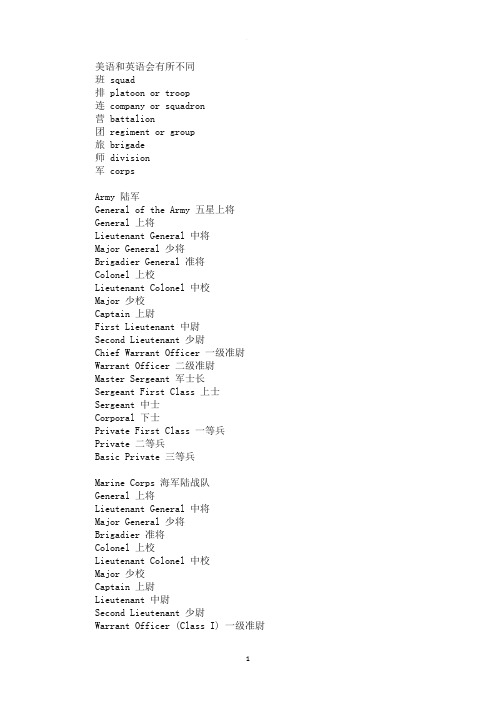
美语和英语会有所不同班 squad排 platoon or troop连 company or squadron营 battalion团 regiment or group旅 brigade师 division军 corpsArmy 陆军General of the Army 五星上将General 上将Lieutenant General 中将Major General 少将Brigadier General 准将Colonel 上校Lieutenant Colonel 中校Major 少校Captain 上尉First Lieutenant 中尉Second Lieutenant 少尉Chief Warrant Officer 一级准尉Warrant Officer 二级准尉Master Sergeant 军士长Sergeant First Class 上士Sergeant 中士Corporal 下士Private First Class 一等兵Private 二等兵Basic Private 三等兵Marine Corps 海军陆战队General 上将Lieutenant General 中将Major General 少将Brigadier 准将Colonel 上校Lieutenant Colonel 中校Major 少校Captain 上尉Lieutenant 中尉Second Lieutenant 少尉Warrant Officer (Class I) 一级准尉Warrant Officer (Class II) 二级准尉Colour Sergeant 上士Sergeant 中士Corporal 下士Marine First Class 一等兵Marine Second Class 二等兵Recruit 新兵Air Force 空军General of the Air Force 五星上将General 上将Lieutenant General 中将Major General 少将Brigadier General 准将Colonel 上校Lieutenant Colonel 中校Mayor 少校Captain 上尉First Lieutenant 中尉Second Lieutenant 少尉Chief Warrant Officer 一级准尉Warrant Officer 二级准尉Master Sergeant 军士长Technical Sergeant 技术军士Staff Sergeant 参谋军士Airman First Class 一等兵Airman Second Class 二等兵Airman Third Class 三等兵Navy 海军Fleet Admiral 五星上将Admiral 上将Vice Admiral 中将Rear Admiral 少将Commodore 准将Captain 上校Commander 中校Lieutenant Commander 少校Lieutenant 上尉Lieutenant Junior Class 中尉Ensign 少尉Commissioned Warrant Officer 一级准尉Warrant Officer 二级准尉Chief Petty Officer 军士长Petty Officer First Class 上士Petty Officer Second Class 中士Petty Officer Third Class 下士Seaman First Class 一等兵Seaman Second Class 二等兵Apprentice Seaman 三等兵Marine Corps 海军陆战队General 上将Lieutenant General 中将Major General 少将Brigadier General 准将Colonel 上校Lieutenant Colonel 中校Major 少校Captain 上尉First Lieutenant 中尉Second Lieutenant 少尉Commissioned Warrant Officer 一级准尉Warrant Officer 二级准尉Master Sergeant 军士长Technical Sergeant 技术军士Staff Sergeant 参谋军士Sergeant 中士Corporal 下士Private First Class 一等兵Private 二等兵欢迎您的下载,资料仅供参考!致力为企业和个人提供合同协议,策划案计划书,学习资料等等打造全网一站式需求。
puml 里的group分组语法

puml 里的group分组语法1. group分组语法概述在 puml (PlantUML) 中,group分组语法用于将相关元素进行分组并以虚线框将它们包围起来,以便于在图表中展示它们之间的关联和归属关系。
group分组语法可以帮助用户更清晰地呈现图表中的信息,提高图表的可读性和易理解性。
2. group分组语法的基本形式在 puml 中,group分组语法的基本形式如下所示:```group "Group Title" {// Grouped elements}```其中,`"Group Title"` 为分组的标题,用户可以根据需要自定义。
`// Grouped elements` 为分组内包含的元素,可以是各种 puml 元素,如对象、类、接口、关系等。
3. group分组语法的示例下面是一个简单的示例,演示了如何使用group分组语法将相关元素进行分组:```class Class1class Class2class Class3group "Group A" {Class1 -- Class2}group "Group B" {Class2 -- Class3}enduml```在上面的示例中,我们创建了三个类 Class1、Class2 和 Class3,并使用 group分组语法将 Class1 和 Class2 以及 Class2 和 Class3 进行了分组。
通过这种方式,我们清晰地展示了这三个类之间的关联关系,并且方便读者快速理解这些类的归属关系。
4. group分组语法的高级用法除了基本形式外,group分组语法还支持一些高级用法,例如创建嵌套的分组、自定义分组的外观样式等。
用户可以通过设置 group 分组的背景色、边框样式和文字样式等属性,来定制分组的外观,使图表更加美观和易读。
在 puml 中,group分组语法是一个非常实用的功能,可以帮助用户更清晰地呈现复杂图表中的信息,提高图表的可读性和易理解性。
class作为集体名词的用法

class作为集体名词的用法
在英语中,class是一个多义词,可以作为集体名词使用。
当class作为集体名词时,它表示一组人或物体的整体,或代表一群人所具有的共同特征或身份。
例如,我们可以说,“The graduating class of 2022 from XYZ High School celebrated their achievements together.” 这里,class代表一群同年级的学生,他们共同完成了他们在高中的学业,并举行了庆祝活动。
另一个例子是,“The class of athletes trained hard for the upcoming competition.” 这句话中,class表示一群运动员,他们正在为即将到来的比赛努力训练。
我们还可以使用class来表达社会或经济地位。
比如,“The upper class enjoys certain privileges not available to the lower class.” 这句话中,class指的是社会阶层,上层阶级有一些下层阶级所没有的特权。
需要注意的是,当class作为集体名词时,它通常与复数动词形式一起使用,因为它指的是一群人或物体。
以上是class作为集体名词的用法。
希望对你有所帮助!。
python group用法
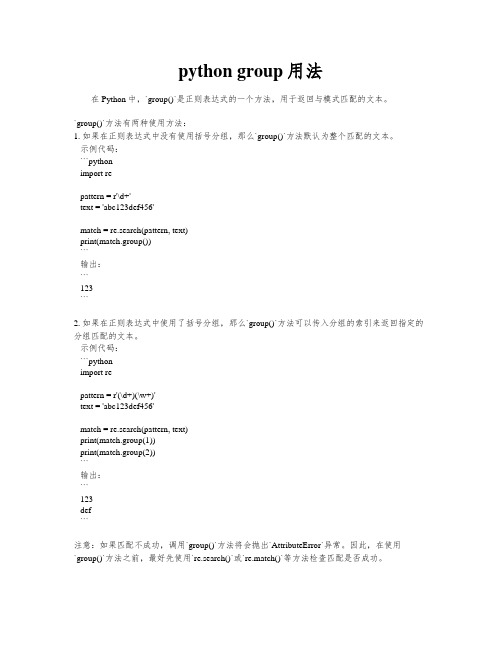
python group用法
在Python中,`group()`是正则表达式的一个方法,用于返回与模式匹配的文本。
`group()`方法有两种使用方法:
1. 如果在正则表达式中没有使用括号分组,那么`group()`方法默认为整个匹配的文本。
示例代码:
```python
import re
pattern = r'\d+'
text = 'abc123def456'
match = re.search(pattern, text)
print(match.group())
```
输出:
```
123
```
2. 如果在正则表达式中使用了括号分组,那么`group()`方法可以传入分组的索引来返回指定的分组匹配的文本。
示例代码:
```python
import re
pattern = r'(\d+)(\w+)'
text = 'abc123def456'
match = re.search(pattern, text)
print(match.group(1))
print(match.group(2))
```
输出:
```
123
def
```
注意:如果匹配不成功,调用`group()`方法将会抛出`AttributeError`异常。
因此,在使用
`group()`方法之前,最好先使用`re.search()`或`re.match()`等方法检查匹配是否成功。
为班级做贡献英语作文
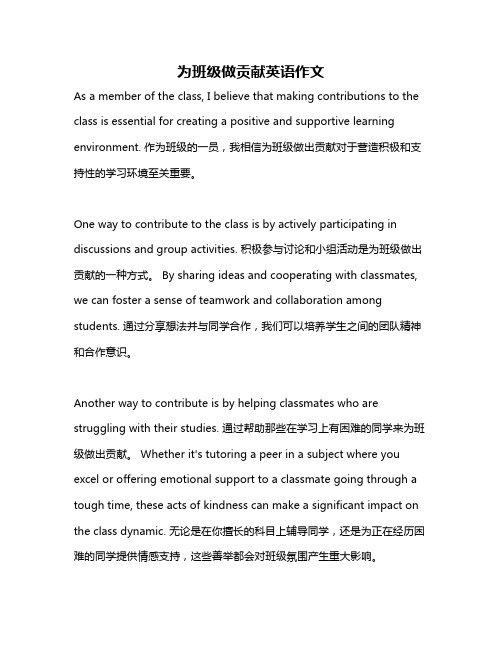
为班级做贡献英语作文As a member of the class, I believe that making contributions to the class is essential for creating a positive and supportive learning environment. 作为班级的一员,我相信为班级做出贡献对于营造积极和支持性的学习环境至关重要。
One way to contribute to the class is by actively participating in discussions and group activities. 积极参与讨论和小组活动是为班级做出贡献的一种方式。
By sharing ideas and cooperating with classmates, we can foster a sense of teamwork and collaboration among students. 通过分享想法并与同学合作,我们可以培养学生之间的团队精神和合作意识。
Another way to contribute is by helping classmates who are struggling with their studies. 通过帮助那些在学习上有困难的同学来为班级做出贡献。
Whether it's tutoring a peer in a subject where you excel or offering emotional support to a classmate going through a tough time, these acts of kindness can make a significant impact on the class dynamic. 无论是在你擅长的科目上辅导同学,还是为正在经历困难的同学提供情感支持,这些善举都会对班级氛围产生重大影响。
英语作文我的班级

In my English composition,I will describe the unique characteristics of my class, which is a vibrant and diverse group of students.Our class is composed of students from various backgrounds,each bringing their own set of skills and interests.This diversity enriches our learning environment,as we are exposed to different perspectives and ideas.One of the most striking features of our class is the camaraderie among the students.We support and encourage each other,creating a positive and inclusive atmosphere.This sense of unity is evident in the way we collaborate on group projects and help each other with difficult assignments.Our class is also characterized by a strong work ethic.We are dedicated to our studies and strive for academic excellence.Our teachers are highly qualified and passionate about their subjects,which inspires us to excel in our learning.In addition to our academic pursuits,our class is involved in various extracurricular activities.We participate in sports,arts,and community service projects,which help us develop wellrounded skills and contribute positively to society.Despite the occasional disagreements and challenges,our class remains a cohesive unit. We learn from our mistakes and grow together as a group.The friendships and memories we create in this class will be cherished for years to come.In conclusion,my class is a dynamic and supportive community that fosters personal and academic growth.We are proud to be part of this group and look forward to the many opportunities and experiences that lie ahead.。
介绍班级作文 英文怎么写
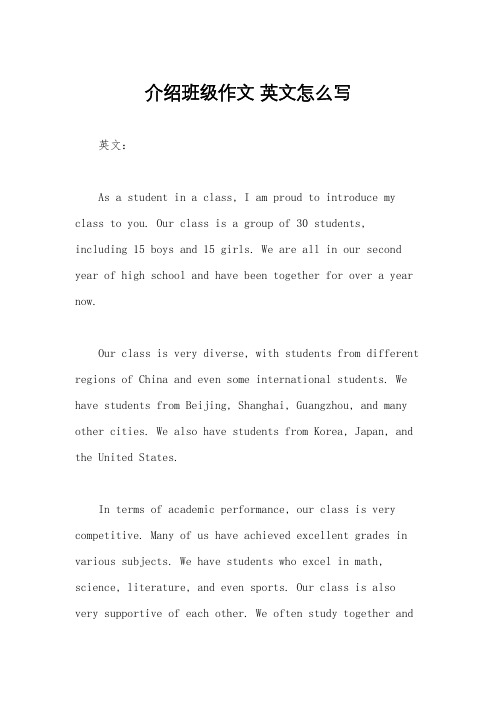
介绍班级作文英文怎么写英文:As a student in a class, I am proud to introduce my class to you. Our class is a group of 30 students,including 15 boys and 15 girls. We are all in our second year of high school and have been together for over a year now.Our class is very diverse, with students from different regions of China and even some international students. We have students from Beijing, Shanghai, Guangzhou, and many other cities. We also have students from Korea, Japan, and the United States.In terms of academic performance, our class is very competitive. Many of us have achieved excellent grades in various subjects. We have students who excel in math, science, literature, and even sports. Our class is also very supportive of each other. We often study together andhelp each other with homework and assignments.Outside of academics, our class is very active in extracurricular activities. We have a school basketball team, a choir, and a drama club. Many of our classmates are also involved in community service projects, such as volunteering at local charities and organizing fundraising events.Overall, I am very proud to be a part of this class. We are a group of diverse, talented, and supportiveindividuals who work hard and have fun together.中文:作为一个班级的学生,我很自豪地向您介绍我们的班级。
SpringBoot数据基础校验_分组校验【GroupValidate】
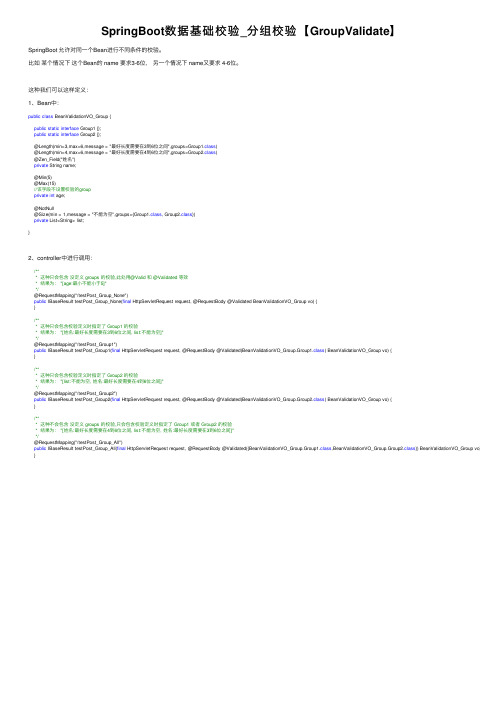
SpringBoot数据基础校验_分组校验【GroupValidate】SpringBoot 允许对同⼀个Bean进⾏不同条件的校验。
⽐如某个情况下这个Bean的 name 要求3-6位,另⼀个情况下 name⼜要求 4-6位。
这种我们可以这样定义:1、Bean中:public class BeanValidationVO_Group {public static interface Group1 {};public static interface Group2 {};@Length(min=3,max=6,message = "最好长度需要在3到6位之间",groups=Group1.class)@Length(min=4,max=6,message = "最好长度需要在4到6位之间",groups=Group2.class)@Zen_Field("姓名")private String name;@Min(5)@Max(15)//该字段不设置校验的groupprivate int age;@NotNull@Size(min = 1,message = "不能为空",groups={Group1.class, Group2.class})private List<String> list;}2、controller中进⾏调⽤:/*** 这种只会包含没定义 groups 的校验,此处⽤@Valid 和 @Validated 等效* 结果为: "[age:最⼩不能⼩于5]"*/@RequestMapping("/testPost_Group_None")public IBaseResult testPost_Group_None(final HttpServletRequest request, @RequestBody @Validated BeanValidationVO_Group vo) {}/*** 这种只会包含校验定义时指定了 Group1 的校验* 结果为: "[姓名:最好长度需要在3到6位之间, list:不能为空]"*/@RequestMapping("/testPost_Group1")public IBaseResult testPost_Group1(final HttpServletRequest request, @RequestBody @Validated(BeanValidationVO_Group.Group1.class) BeanValidationVO_Group vo) {}/*** 这种只会包含校验定义时指定了 Group2 的校验* 结果为: "[list:不能为空, 姓名:最好长度需要在4到6位之间]"*/@RequestMapping("/testPost_Group2")public IBaseResult testPost_Group2(final HttpServletRequest request, @RequestBody @Validated(BeanValidationVO_Group.Group2.class) BeanValidationVO_Group vo) {}/*** 这种不会包含没定义 groups 的校验,只会包含校验定义时指定了 Group1 或者 Group2 的校验* 结果为: "[姓名:最好长度需要在4到6位之间, list:不能为空, 姓名:最好长度需要在3到6位之间]"*/@RequestMapping("/testPost_Group_All")public IBaseResult testPost_Group_All(final HttpServletRequest request, @RequestBody @Validated({BeanValidationVO_Group.Group1.class,BeanValidationVO_Group.Group2.class}) BeanValidationVO_Group vo) { }。
WinCC 中VBS的对象与事件

私有Private 共有public
Public repiceName '定义变量 Public linespeed Class user 'Property Get语句,获取属性值或对象引用,Default只与Public一起使用,表示该属性为类的默认属性 Public Property Get Myname
3. CLASS 对象
进入全局脚本,在全局脚本输入以下脚本,创建类
Class TestClass Private Sub Class_Initialize ‘ 设置 Initialize 事件 MsgBox("TestClass started") End Sub Private Sub Class_Terminate ‘ 设置 Terminate 事件 MsgBox("TestClass terminated") End Sub End Class
DataSet 组创建
写组,同时把组值输出到输入/输出域
Dim group,a,b Set group = HMIRuntime.Tags.CreateTagSet group.Add “Motor1“ ‘Motor1必须是变量管理器已经有的 group.Add "Motor2“ ‘Motor2必须是变量管理器已经有的 group("Motor1").Value = 3 group("Motor2").Value = 9 group.Write Set a =ScreenItems("输入/输出域1") Set b =ScreenItems("输入/输出域2") a.OutputValue=group("Motor1").Value b.OutputValue=group("Motor2").Value
class4group5 语体意识
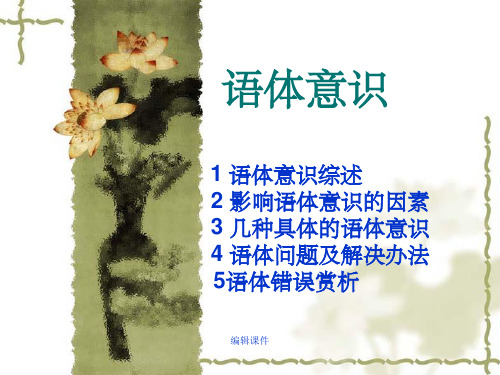
3表达严谨
编辑课件
1.译文必须符合法律语言的特征 译文的语言必须反映出目标语中法律语言的特
点 。例如一些法规将“但是”翻译成“but”或者 “however”,这样的翻译不符合法律英语的特点, 应该改译成更符合法律英语语体的“provided that”。 同样“并且”不应译成“also”而应译成“in addition”。英语法律文本中的“children”不应简单 翻译成“儿童”而可能根据语境翻译成“未成年 人”。
二、语法结构层面的分析
首先,从语法结构来看,商务英语具有很强的正式 性语体特征,这和科技语体与公文语体有着许多相 似之处。具体特征如下:
编辑课件
1.句式完整,结构复杂 商务英语文本中的句式比较完整,变化也较少,多 用完整句及长句,较少使用省略句或短句。这些都 是正式文体的特征。由于商务英语主要是用于传递 商务信息、陈述商务事实,既然是涉及商业金融要 务,语言自然是应该端庄得体,叙述也应全面严谨, 富有逻辑性。所以在商务英语中,主从复合句、同 位语、插入语的使用率也比较高。一些可以表示逻 辑关系的词如:accordingly,however, furthermore,on the contrary,as a result, consequently等有助于叙述、归纳和概括的词经常 会被用到。此外,商务英语文本不大需要激发读者 的感情,因此基本上不使用感叹句、反意问句等, 也很少使用夸张、拟人、借代、比喻等修辞手法。 这与文学语言结构形成鲜明对照。
上有问题,但A 仍能理解。但在叙事或独自中,需 有完整的句法结构A asks B to go to
classroom ,and B agrees. 编辑课件
商务英语中的语体意识 ——特征可以被概括为三点,即,正式性、专业性 和程式性。在商务英语的语法结构和使用词汇范围 两个方面有许多相关语体成分展现,通过对这些语 体成分的收集与分析,可以清楚地描述商务英语的 正式性、专业性与程式性语体特征。
group by all语法
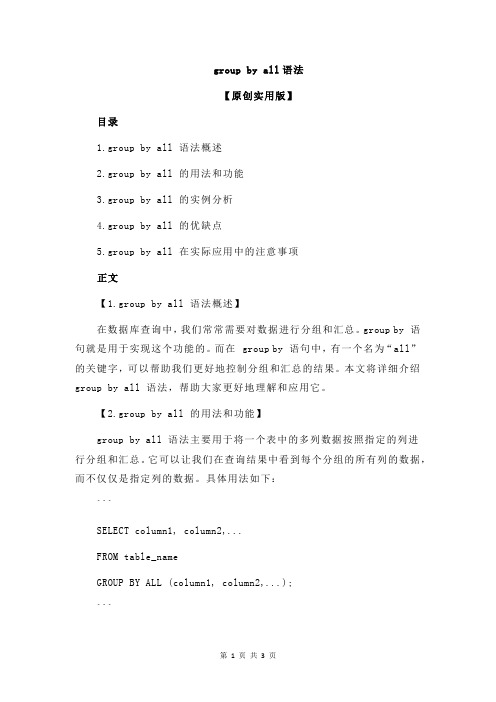
group by all语法【原创实用版】目录1.group by all 语法概述2.group by all 的用法和功能3.group by all 的实例分析4.group by all 的优缺点5.group by all 在实际应用中的注意事项正文【1.group by all 语法概述】在数据库查询中,我们常常需要对数据进行分组和汇总。
group by 语句就是用于实现这个功能的。
而在 group by 语句中,有一个名为“all”的关键字,可以帮助我们更好地控制分组和汇总的结果。
本文将详细介绍group by all 语法,帮助大家更好地理解和应用它。
【2.group by all 的用法和功能】group by all 语法主要用于将一个表中的多列数据按照指定的列进行分组和汇总。
它可以让我们在查询结果中看到每个分组的所有列的数据,而不仅仅是指定列的数据。
具体用法如下:```SELECT column1, column2,...FROM table_nameGROUP BY ALL (column1, column2,...);```这里,column1、column2 等表示需要分组的列,table_name 表示要查询的表名。
【3.group by all 的实例分析】假设我们有一个名为“students”的表,包含以下字段:id, name, gender, age, class。
现在,我们想要查询每个班级中不同性别的学生数量。
使用 group by all 语法,我们可以这样写查询语句:```SELECT class, gender, COUNT(*)FROM studentsGROUP BY ALL (class, gender);```这个查询语句将按照班级和性别两个维度对学生数据进行分组和汇总,最终返回每个班级中不同性别的学生数量。
【4.group by all 的优缺点】group by all 的优点是可以让我们在查询结果中看到每个分组的所有列的数据,更加直观和全面。
virtuoso中的group用法 -回复
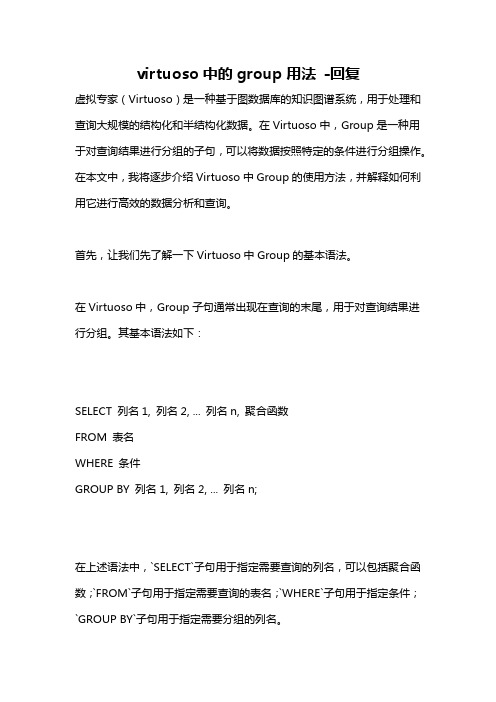
virtuoso中的group用法-回复虚拟专家(Virtuoso)是一种基于图数据库的知识图谱系统,用于处理和查询大规模的结构化和半结构化数据。
在Virtuoso中,Group是一种用于对查询结果进行分组的子句,可以将数据按照特定的条件进行分组操作。
在本文中,我将逐步介绍Virtuoso中Group的使用方法,并解释如何利用它进行高效的数据分析和查询。
首先,让我们先了解一下Virtuoso中Group的基本语法。
在Virtuoso中,Group子句通常出现在查询的末尾,用于对查询结果进行分组。
其基本语法如下:SELECT 列名1, 列名2, ... 列名n, 聚合函数FROM 表名WHERE 条件GROUP BY 列名1, 列名2, ... 列名n;在上述语法中,`SELECT`子句用于指定需要查询的列名,可以包括聚合函数;`FROM`子句用于指定需要查询的表名;`WHERE`子句用于指定条件;`GROUP BY`子句用于指定需要分组的列名。
接下来,让我们通过一个具体的示例来演示Virtuoso中Group的使用。
假设我们有一个名为“Employees”的表,其中包含员工的姓名、部门和薪水信息。
我们想要查询每个部门的平均薪水和员工数。
下面是查询的具体步骤:Step 1:编写基本的查询语句SELECT Department, AVG(Salary) AS AverageSalary, COUNT(*) AS EmployeeCountFROM Employees在这个查询中,我们选择了部门(Department)列、平均薪水(AverageSalary)和员工数(EmployeeCount)这三个列。
注意,我们使用了AVG()函数来计算平均薪水,并使用COUNT()函数计算员工数。
Step 2:添加Group子句SELECT Department, AVG(Salary) AS AverageSalary, COUNT(*) AS EmployeeCountFROM EmployeesGROUP BY Department在这一步中,我们在查询的末尾添加了`GROUP BY Department`,表示按照部门对结果进行分组。
